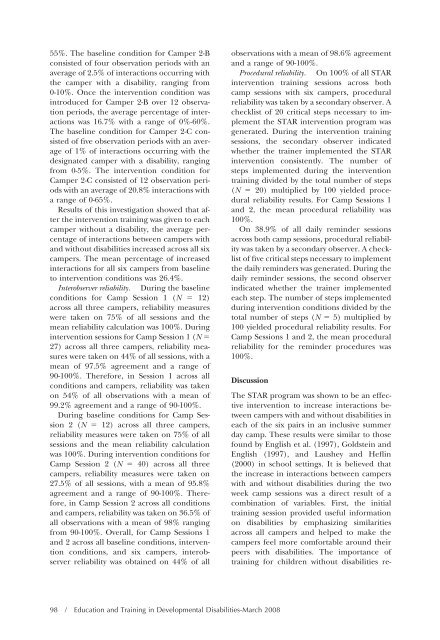Download the Journal (PDF) - Division on Autism and ...
Download the Journal (PDF) - Division on Autism and ...
Download the Journal (PDF) - Division on Autism and ...
Create successful ePaper yourself
Turn your PDF publications into a flip-book with our unique Google optimized e-Paper software.
55%. The baseline c<strong>on</strong>diti<strong>on</strong> for Camper 2-B<br />
c<strong>on</strong>sisted of four observati<strong>on</strong> periods with an<br />
average of 2.5% of interacti<strong>on</strong>s occurring with<br />
<str<strong>on</strong>g>the</str<strong>on</strong>g> camper with a disability, ranging from<br />
0-10%. Once <str<strong>on</strong>g>the</str<strong>on</strong>g> interventi<strong>on</strong> c<strong>on</strong>diti<strong>on</strong> was<br />
introduced for Camper 2-B over 12 observati<strong>on</strong><br />
periods, <str<strong>on</strong>g>the</str<strong>on</strong>g> average percentage of interacti<strong>on</strong>s<br />
was 16.7% with a range of 0%-60%.<br />
The baseline c<strong>on</strong>diti<strong>on</strong> for Camper 2-C c<strong>on</strong>sisted<br />
of five observati<strong>on</strong> periods with an average<br />
of 1% of interacti<strong>on</strong>s occurring with <str<strong>on</strong>g>the</str<strong>on</strong>g><br />
designated camper with a disability, ranging<br />
from 0-5%. The interventi<strong>on</strong> c<strong>on</strong>diti<strong>on</strong> for<br />
Camper 2-C c<strong>on</strong>sisted of 12 observati<strong>on</strong> periods<br />
with an average of 20.8% interacti<strong>on</strong>s with<br />
a range of 0-65%.<br />
Results of this investigati<strong>on</strong> showed that after<br />
<str<strong>on</strong>g>the</str<strong>on</strong>g> interventi<strong>on</strong> training was given to each<br />
camper without a disability, <str<strong>on</strong>g>the</str<strong>on</strong>g> average percentage<br />
of interacti<strong>on</strong>s between campers with<br />
<strong>and</strong> without disabilities increased across all six<br />
campers. The mean percentage of increased<br />
interacti<strong>on</strong>s for all six campers from baseline<br />
to interventi<strong>on</strong> c<strong>on</strong>diti<strong>on</strong>s was 26.4%.<br />
Interobserver reliability. During <str<strong>on</strong>g>the</str<strong>on</strong>g> baseline<br />
c<strong>on</strong>diti<strong>on</strong>s for Camp Sessi<strong>on</strong> 1 (N 12)<br />
across all three campers, reliability measures<br />
were taken <strong>on</strong> 75% of all sessi<strong>on</strong>s <strong>and</strong> <str<strong>on</strong>g>the</str<strong>on</strong>g><br />
mean reliability calculati<strong>on</strong> was 100%. During<br />
interventi<strong>on</strong> sessi<strong>on</strong>s for Camp Sessi<strong>on</strong> 1 (N <br />
27) across all three campers, reliability measures<br />
were taken <strong>on</strong> 44% of all sessi<strong>on</strong>s, with a<br />
mean of 97.5% agreement <strong>and</strong> a range of<br />
90-100%. Therefore, in Sessi<strong>on</strong> 1 across all<br />
c<strong>on</strong>diti<strong>on</strong>s <strong>and</strong> campers, reliability was taken<br />
<strong>on</strong> 54% of all observati<strong>on</strong>s with a mean of<br />
99.2% agreement <strong>and</strong> a range of 90-100%.<br />
During baseline c<strong>on</strong>diti<strong>on</strong>s for Camp Sessi<strong>on</strong><br />
2 (N 12) across all three campers,<br />
reliability measures were taken <strong>on</strong> 75% of all<br />
sessi<strong>on</strong>s <strong>and</strong> <str<strong>on</strong>g>the</str<strong>on</strong>g> mean reliability calculati<strong>on</strong><br />
was 100%. During interventi<strong>on</strong> c<strong>on</strong>diti<strong>on</strong>s for<br />
Camp Sessi<strong>on</strong> 2 (N 40) across all three<br />
campers, reliability measures were taken <strong>on</strong><br />
27.5% of all sessi<strong>on</strong>s, with a mean of 95.8%<br />
agreement <strong>and</strong> a range of 90-100%. Therefore,<br />
in Camp Sessi<strong>on</strong> 2 across all c<strong>on</strong>diti<strong>on</strong>s<br />
<strong>and</strong> campers, reliability was taken <strong>on</strong> 36.5% of<br />
all observati<strong>on</strong>s with a mean of 98% ranging<br />
from 90-100%. Overall, for Camp Sessi<strong>on</strong>s 1<br />
<strong>and</strong> 2 across all baseline c<strong>on</strong>diti<strong>on</strong>s, interventi<strong>on</strong><br />
c<strong>on</strong>diti<strong>on</strong>s, <strong>and</strong> six campers, interobserver<br />
reliability was obtained <strong>on</strong> 44% of all<br />
observati<strong>on</strong>s with a mean of 98.6% agreement<br />
<strong>and</strong> a range of 90-100%.<br />
Procedural reliability. On 100% of all STAR<br />
interventi<strong>on</strong> training sessi<strong>on</strong>s across both<br />
camp sessi<strong>on</strong>s with six campers, procedural<br />
reliability was taken by a sec<strong>on</strong>dary observer. A<br />
checklist of 20 critical steps necessary to implement<br />
<str<strong>on</strong>g>the</str<strong>on</strong>g> STAR interventi<strong>on</strong> program was<br />
generated. During <str<strong>on</strong>g>the</str<strong>on</strong>g> interventi<strong>on</strong> training<br />
sessi<strong>on</strong>s, <str<strong>on</strong>g>the</str<strong>on</strong>g> sec<strong>on</strong>dary observer indicated<br />
whe<str<strong>on</strong>g>the</str<strong>on</strong>g>r <str<strong>on</strong>g>the</str<strong>on</strong>g> trainer implemented <str<strong>on</strong>g>the</str<strong>on</strong>g> STAR<br />
interventi<strong>on</strong> c<strong>on</strong>sistently. The number of<br />
steps implemented during <str<strong>on</strong>g>the</str<strong>on</strong>g> interventi<strong>on</strong><br />
training divided by <str<strong>on</strong>g>the</str<strong>on</strong>g> total number of steps<br />
(N 20) multiplied by 100 yielded procedural<br />
reliability results. For Camp Sessi<strong>on</strong>s 1<br />
<strong>and</strong> 2, <str<strong>on</strong>g>the</str<strong>on</strong>g> mean procedural reliability was<br />
100%.<br />
On 38.9% of all daily reminder sessi<strong>on</strong>s<br />
across both camp sessi<strong>on</strong>s, procedural reliability<br />
was taken by a sec<strong>on</strong>dary observer. A checklist<br />
of five critical steps necessary to implement<br />
<str<strong>on</strong>g>the</str<strong>on</strong>g> daily reminders was generated. During <str<strong>on</strong>g>the</str<strong>on</strong>g><br />
daily reminder sessi<strong>on</strong>s, <str<strong>on</strong>g>the</str<strong>on</strong>g> sec<strong>on</strong>d observer<br />
indicated whe<str<strong>on</strong>g>the</str<strong>on</strong>g>r <str<strong>on</strong>g>the</str<strong>on</strong>g> trainer implemented<br />
each step. The number of steps implemented<br />
during interventi<strong>on</strong> c<strong>on</strong>diti<strong>on</strong>s divided by <str<strong>on</strong>g>the</str<strong>on</strong>g><br />
total number of steps (N 5) multiplied by<br />
100 yielded procedural reliability results. For<br />
Camp Sessi<strong>on</strong>s 1 <strong>and</strong> 2, <str<strong>on</strong>g>the</str<strong>on</strong>g> mean procedural<br />
reliability for <str<strong>on</strong>g>the</str<strong>on</strong>g> reminder procedures was<br />
100%.<br />
Discussi<strong>on</strong><br />
98 / Educati<strong>on</strong> <strong>and</strong> Training in Developmental Disabilities-March 2008<br />
The STAR program was shown to be an effective<br />
interventi<strong>on</strong> to increase interacti<strong>on</strong>s between<br />
campers with <strong>and</strong> without disabilities in<br />
each of <str<strong>on</strong>g>the</str<strong>on</strong>g> six pairs in an inclusive summer<br />
day camp. These results were similar to those<br />
found by English et al. (1997), Goldstein <strong>and</strong><br />
English (1997), <strong>and</strong> Laushey <strong>and</strong> Heflin<br />
(2000) in school settings. It is believed that<br />
<str<strong>on</strong>g>the</str<strong>on</strong>g> increase in interacti<strong>on</strong>s between campers<br />
with <strong>and</strong> without disabilities during <str<strong>on</strong>g>the</str<strong>on</strong>g> two<br />
week camp sessi<strong>on</strong>s was a direct result of a<br />
combinati<strong>on</strong> of variables. First, <str<strong>on</strong>g>the</str<strong>on</strong>g> initial<br />
training sessi<strong>on</strong> provided useful informati<strong>on</strong><br />
<strong>on</strong> disabilities by emphasizing similarities<br />
across all campers <strong>and</strong> helped to make <str<strong>on</strong>g>the</str<strong>on</strong>g><br />
campers feel more comfortable around <str<strong>on</strong>g>the</str<strong>on</strong>g>ir<br />
peers with disabilities. The importance of<br />
training for children without disabilities re-
















